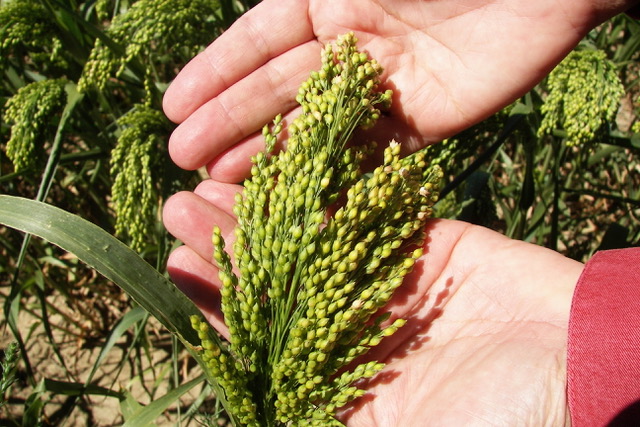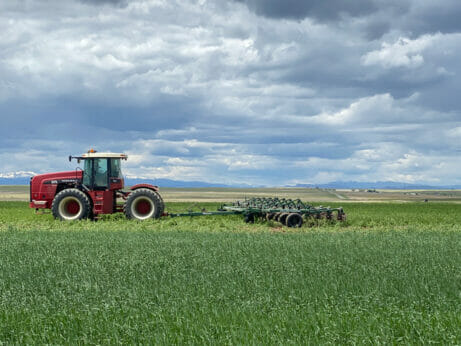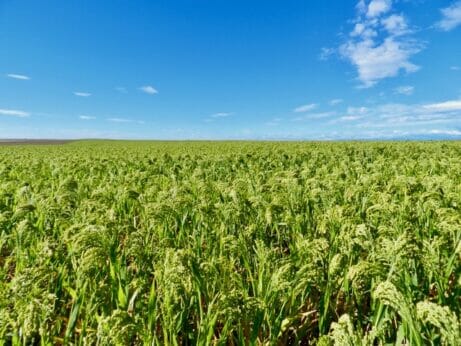Millet is Having a Moment. Is the Ancient Grain Ready for a Resurgence?
The United Nations has named 2023 the Year of Millets. The drought-tolerant cereal crop is being touted as an important food source in the face of climate change.
Millet is Having a Moment. Is the Ancient Grain Ready for a Resurgence?
The United Nations has named 2023 the Year of Millets. The drought-tolerant cereal crop is being touted as an important food source in the face of climate change.

Jean Hediger grows Proso millet on her Nunn, Colorado farmcourtesy of Jean Hediger
The UN’s Food and Agriculture Organization (FAO) has declared 2023 the international year of millets, praising the grain’s ability to grow in arid soil with minimal inputs. For many farmers, 2023 could be the year they first meet millet. But Jean Hediger is wondering what took everyone else so long to catch up. Hediger has been celebrating the crop on her Nunn, CO farm ever since she began growing it more than two decades ago.
“Lots of the farmers here, they joke and call me the queen of millet,” she says. “We’re very enthusiastic about millets for a lot of reasons, but how can you not be? You look at it sideways and the crop just wants to grow.”

On the high plains of her farm, Golden Prairie, this water-efficient whole grain has consistently produced a harvest since the family mixed it into a crop rotation with their hard red winter wheat. The demand for it began to shoot up over the years, Hediger says, largely in part to the emergence of the gluten-free and celiac diet, as millet doesn’t contain gluten.
But now with drought and water shortages becoming more prevalent across the country, Hediger says her phone has been ringing off the hook as more growers are looking for ways they can grow a crop and use less water. As Hediger’s land typically receives less than 15 inches of rain each year, she’s very familiar with millet’s ability to grow in parched conditions.
Hediger grows Proso millet, one of the most commonly grown varieties, which produces a seed within 60 to 90 days. Proso, also known as common millet, could become even more common, as Hediger anticipates the UN’s platform will give rise to its popularity even more.
“In America, our idea of a grain is Uncle Ben’s white rice,” she says. “I see this being a critical moment to educate people.”
Although millet is not as well known as other cereal crops such as wheat and rice, it’s considered to be an ancient crop, first cultivated in Asia more than 4,000 years ago. It continues to be a staple crop in the continent’s semi-arid regions, and it is grown and consumed widely in India, Mali, Niger and Nigeria. In the U.S., the crop has been adopted in eastern Colorado, western Nebraska and North and South Dakota.
Increasing millet’s prevalence in global diets by 10 percent would result in strong co-benefits between increased nutrient supply and reduced environmental impacts, according to a 2021 study published in Environmental Research Letters.
Kelly LeBlanc, director of nutrition at the non-profit Oldways Whole Grains Council, says millet’s drought tolerance is due to the fact that it’s a C4 cereal, meaning it produces a “4-carbon” compound. This allows it to be more water-efficient, by retaining more water vapor in photosynthesis.
“The year of millets is significant, because it will raise awareness of these underutilized whole grains,” says LeBlanc. “We hope to see the interest in millets grow.”
There are many different types of millets, and some may be better suited to certain regions than others. According to the National Research Council, finger millet is best for upland and humid areas, while pearl millet does better in dry areas, as it can withstand heat and low moisture.
LeBlanc also points to the crop’s nutritional value: A 45-gram serving of millet has about five grams of protein and four grams of fiber, and it is a good source of nutrients such as magnesium, phosphorus, thiamin, niacin, vitamin B6 and folate. Some finger millet varieties also have high levels of methionine, which is an essential amino acid that is often lacking in starch-based diets.

It’s described as having a nutty flavor, with a creamy, slightly chewy texture. Hediger has an entire guide on her farm’s website providing recipe inspiration for those unsure about how to cook with it. The easiest way to think about it is a rice substitute, she says.
Hediger, who notes her state of Colorado accounts for 60 percent of organic millet production, believes millet is due for a comeback. Deciding to adopt the crop into her farm model continues to be one of the best decisions she’s made.
Follow us

This work is licensed under a Creative Commons Attribution-NoDerivatives 4.0 International License.
Want to republish a Modern Farmer story?
We are happy for Modern Farmer stories to be shared, and encourage you to republish our articles for your audience. When doing so, we ask that you follow these guidelines:
Please credit us and our writers
For the author byline, please use “Author Name, Modern Farmer.” At the top of our stories, if on the web, please include this text and link: “This story was originally published by Modern Farmer.”
Please make sure to include a link back to either our home page or the article URL.
At the bottom of the story, please include the following text:
“Modern Farmer is a nonprofit initiative dedicated to raising awareness and catalyzing action at the intersection of food, agriculture, and society. Read more at <link>Modern Farmer</link>.”
Use our widget
We’d like to be able to track our stories, so we ask that if you republish our content, you do so using our widget (located on the left hand side of the article). The HTML code has a built-in tracker that tells us the data and domain where the story was published, as well as view counts.
Check the image requirements
It’s your responsibility to confirm you're licensed to republish images in our articles. Some images, such as those from commercial providers, don't allow their images to be republished without permission or payment. Copyright terms are generally listed in the image caption and attribution. You are welcome to omit our images or substitute with your own. Charts and interactive graphics follow the same rules.
Don’t change too much. Or, ask us first.
Articles must be republished in their entirety. It’s okay to change references to time (“today” to “yesterday”) or location (“Iowa City, IA” to “here”). But please keep everything else the same.
If you feel strongly that a more material edit needs to be made, get in touch with us at [email protected]. We’re happy to discuss it with the original author, but we must have prior approval for changes before publication.
Special cases
Extracts. You may run the first few lines or paragraphs of the article and then say: “Read the full article at Modern Farmer” with a link back to the original article.
Quotes. You may quote authors provided you include a link back to the article URL.
Translations. These require writer approval. To inquire about translation of a Modern Farmer article, contact us at [email protected]
Signed consent / copyright release forms. These are not required, provided you are following these guidelines.
Print. Articles can be republished in print under these same rules, with the exception that you do not need to include the links.
Tag us
When sharing the story on social media, please tag us using the following: - Twitter (@ModFarm) - Facebook (@ModernFarmerMedia) - Instagram (@modfarm)
Use our content respectfully
Modern Farmer is a nonprofit and as such we share our content for free and in good faith in order to reach new audiences. Respectfully,
No selling ads against our stories. It’s okay to put our stories on pages with ads.
Don’t republish our material wholesale, or automatically; you need to select stories to be republished individually.
You have no rights to sell, license, syndicate, or otherwise represent yourself as the authorized owner of our material to any third parties. This means that you cannot actively publish or submit our work for syndication to third party platforms or apps like Apple News or Google News. We understand that publishers cannot fully control when certain third parties automatically summarize or crawl content from publishers’ own sites.
Keep in touch
We want to hear from you if you love Modern Farmer content, have a collaboration idea, or anything else to share. As a nonprofit outlet, we work in service of our community and are always open to comments, feedback, and ideas. Contact us at [email protected].by Lindsay Campbell, Modern Farmer
December 27, 2022
Modern Farmer Weekly
Solutions Hub
Innovations, ideas and inspiration. Actionable solutions for a resilient food system.
ExploreExplore other topics
Share With Us
We want to hear from Modern Farmer readers who have thoughtful commentary, actionable solutions, or helpful ideas to share.
SubmitNecessary cookies are absolutely essential for the website to function properly. This category only includes cookies that ensures basic functionalities and security features of the website. These cookies do not store any personal information.
Any cookies that may not be particularly necessary for the website to function and are used specifically to collect user personal data via analytics, ads, other embedded contents are termed as non-necessary cookies.
So good to read about farmers who have adapted years ago to growing crops suitable for the climate change we are experiencing and is far more nutritious.
Had a farmer in South Dakota tell me that if he got an inch of rain he had a crop. I raise it in Northern Wisconsin as forage instead of Sorghum Sudan grass. Never combined it, but you can always count on it.
Good to hear that Jean is successfully growing Proso Millet for last 2 decades and now guiding other US Farmers too. Millets also known as Shreeanna in India have been growing for thousands of years throughtput all continents as being discovered by archeologists, for the simple reason that it hardly requires any fertiliser or pesticide too besides low water requirement being C4 crops. Consumption has increased tremendously due to the Central Government and State Governments focus and handsome budgets allocated to promote the same bringing demands at garm level. Would love to visit US for having nutritious meals & breakfast… Read more »
Needs rebranding. “Millet” evokes imagery of “maggot”.